Damascus: Holy Fervor
When the Hebrew Saul of Taursus experienced his revelation of faith on the road to Damascus, the city was already thousands of years old. I remember the story of the Apostle Paul being drilled into me in long-ago Sunday School classes; I find it hard to believe I will be visiting this ancient city in the present day.
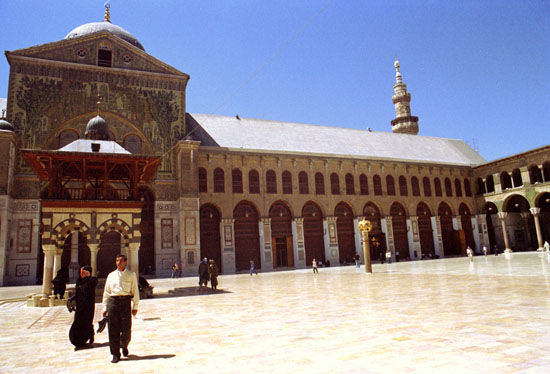
On arrival from Jordan in a service taxi, I am promptly scammed. It's relatively harmless and the only time I experience dishonesty in 2 weeks in Syria, but it's still annoying to have a taxi driver insist his meter does not work, then charge 200SYP to drive approximately 75 seconds, pointing vaguely down an alleyway at my hotel.
 |
 |
I enter the Souk al-Hamidiyeh many times, as it's my path to the Umayyad Mosque and Hammam al-Qaimariyya and home to the addictive Bakdesh ice cream. The wide covered main street is easy for tourists to navigate. The offshoots tend to be more interesting. There doesn't appear to be a true order to the storefronts. Jewelry stores are next to nightgown shops, which are next to falafel stands. It's a great place to lose myself for a while.
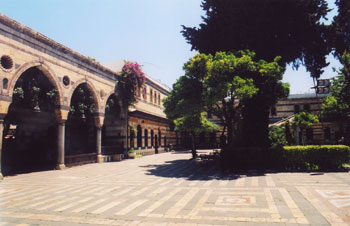 |
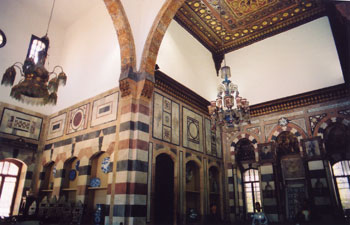 |
The design of Azem Palace is striking, composed of stripes of black limestone and white basalt. The Palace was the home of Assad Pasha al-Azem, Ottoman governor of Damascus for 14 years. Now it is used as the Museum of Popular Arts and Traditions, complete with mannequins re-enacting bathing in a hammam. Other rooms demonstrate families receiving guests or preparing for a wedding.
 |
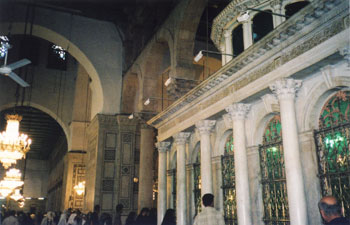 |
I am required to rent a long, shapeless green robe here for 50SYP and requested to keep my hair covered at all times. I have difficulty keeping the hood on when I tie my hair back, but when I let it back down, the errant strands peeking out from my hood draw disapproving looks. Shoes come off at the door; I hold on to mine in case a tip is required to get them back from the clerks.
Damascus was the capitol of the Umayyad Empire, and the beautiful mosque built between 705AD and 715AD was the first of its kind, influencing mosque design throughout the Islamic world. The courtyard is marvelous, spacious, and decorated with mosaics.
I'm not positive, but I think there are doors I'm not allowed to enter. I see people pouring in when we hear the call to prayer, but I don't know if I'm prevented for not being Muslim or simply for being a woman. Going in through another door I see the shrine containing John the Baptist's head.
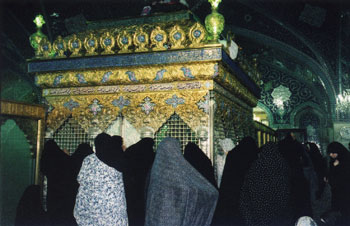 |
I enter through a separate smaller door for women and am given a black robe; again, I vainly try to keep my hair hidden to avoid glares. I am not allowed to keep my shoes; a clerk takes them (they're in embarrassing condition) and gives me a number. The mosque is much smaller than Umayyad, with a courtyard covered in lovely rugs; unlike Umayyad, here people pray right in the courtyard.
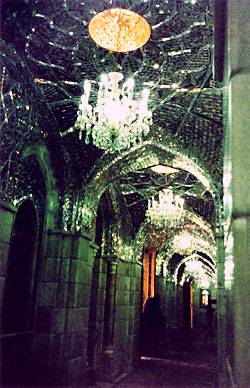 |
I don't know what's happening in here. I really wish I did. Iranian women are crying at the foot of Ruqqaya's shrine. Their passion ebbs and flows, sometimes wailing, sometimes contemplative. The cloaked women sing, throw money into the shrine, and rub small girl's dresses against its walls. They also distribute candy, I note when a few pieces are pressed into my hand; I wonder if this bit of sustenance indicates how long they plan to stay in these spots. Candy is also thrown into the shrine. I look out the doorway and see the group of men again, far from the commotion, caught up in their dance. There are two different worlds inside Saida Ruqqaya mosque; including my bubble of bemused fascination, there are three.